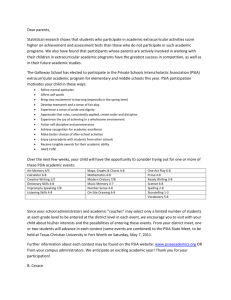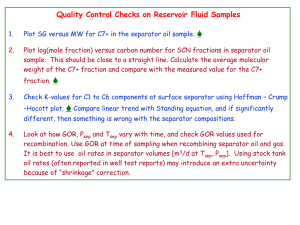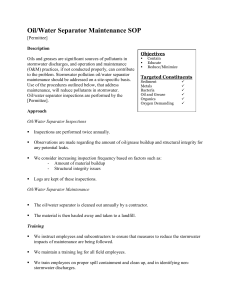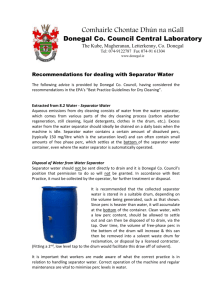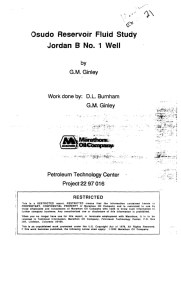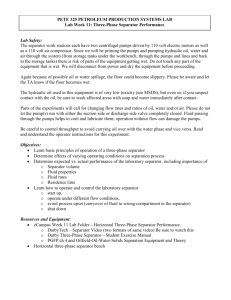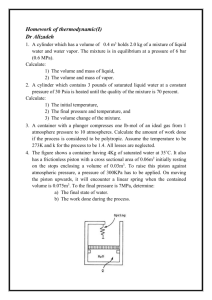Reservoir Fluid Studies (DL, CCE, Separator Tests)
advertisement
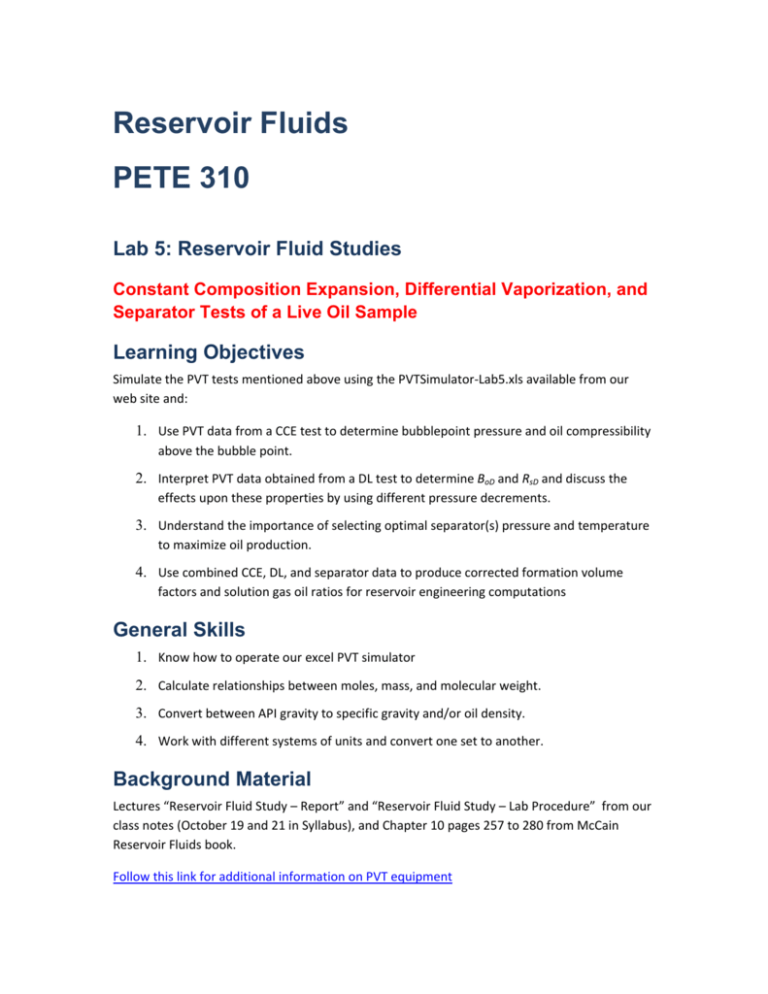
Reservoir Fluids PETE 310 Lab 5: Reservoir Fluid Studies Constant Composition Expansion, Differential Vaporization, and Separator Tests of a Live Oil Sample Learning Objectives Simulate the PVT tests mentioned above using the PVTSimulator‐Lab5.xls available from our web site and: 1. Use PVT data from a CCE test to determine bubblepoint pressure and oil compressibility above the bubble point. 2. Interpret PVT data obtained from a DL test to determine BoD and RsD and discuss the effects upon these properties by using different pressure decrements. 3. Understand the importance of selecting optimal separator(s) pressure and temperature to maximize oil production. 4. Use combined CCE, DL, and separator data to produce corrected formation volume factors and solution gas oil ratios for reservoir engineering computations General Skills 1. Know how to operate our excel PVT simulator 2. Calculate relationships between moles, mass, and molecular weight. 3. Convert between API gravity to specific gravity and/or oil density. 4. Work with different systems of units and convert one set to another. Background Material Lectures “Reservoir Fluid Study – Report” and “Reservoir Fluid Study – Lab Procedure” from our class notes (October 19 and 21 in Syllabus), and Chapter 10 pages 257 to 280 from McCain Reservoir Fluids book. Follow this link for additional information on PVT equipment Lab # 5 Tutorial Example How to Process PVT Information from CCE, DL, and Separator Tests The following example guides you on how to use and interpret the data from a CCE, a DL test and a separator test. The reservoir temperature is T= 220oF and the initial reservoir pressure is 2200 psia. A recorded presentation with hints provides details on how to use the excel file. This tutorial presents the data obtained and the calculations with the data. Fig. 1—Compositional information allows users to enter the number of moles of each component. Constant Composition Expansion (CCE) Results Table 1 shows the CCE data with pressure steps of 100 psia, here the experiment ends at 1,600 psia . The output table displays the liquid and vapor fraction, the compressibility factor, and the volumes of oil and gas at each pressure stage. From this table you can find the bubblepoint pressure graphically or numerically as indicated in class. Table 1—Constant Composition Expansion Results Pressure fo fg zo zg Vo, cm3 Vg, cm3 2200.0 1.0000 0.0000 1.0951 0.0000 30.3196 0.0000 2100.0 1.0000 0.0000 1.0466 0.0000 30.3562 0.0000 1995.5 1.0000 0.0000 0.9958 0.8989 30.3952 0.0001 1800.0 0.9502 0.0498 0.9335 0.9013 30.0161 1.5177 1600.0 0.9012 0.0988 0.8640 0.9050 29.6407 3.4032 Lab#5 –PETE 310 From Table 1 we can see that the bubblepoint pressure for this mixture is between 2100 an 1800 psia. Refining the search provides pb = 1995 psi, note that at this pressure the volume of gas obtained is very small. Differential Liberation This experiment begins at the bubblepoint pressure determined from the CCE. The oil sample is subject to a series of expansions as indicated in the lectures. For this example the pressure steps are 500 psia, you can and will have to discuss the effect of the size of pressure decrements in the computed properties. One stage at 14.7 psia and reservoir temperature and another stage at 14.7 psia and 60°F are automatically added into the experiment. Table 2 displays the differential liberation results for our example mixture. This output includes the fraction of liquid and vapor, the compressibility factor, and the volume of oil and gas at the specified pressure and temperature. This volume of gas is removed from the cell before the next expansion. Using data from this table you can compute Rsd, Bod, and Bg using the procedure explained in class. Table 2—Differential Liberation results at T=220oF Pressure, fo fg zo zg Vo, cm3 Vg, cm3 1995.5 1.0000 0.0000 0.9958 0.8989 30.3952 0.0001 1500.0 0.8774 0.1226 0.8268 0.9075 29.4571 4.5187 1000.0 0.8720 0.1280 0.6135 0.9249 28.5852 6.3285 500.0 0.8634 0.1366 0.3449 0.9518 27.7497 12.1138 14.7 0.7850 0.2150 0.0122 0.9946 26.2210 585.2771 14.7 (at 60ºF) 1.0000 0.0000 0.0154 0.0000 25.3069 0.0000 psi Separator Tests The objectives of the separator tests are to optimize the amount of oil produced at the surface. You will conduct tests with one and two separators; your goal is to find the best pressure and temperature combinations (for one or multiple separators) that maximize liquid production. The stock tank, which acts as another separator at standard temperature and pressure, is included automatically in your computation. Lab#5 –PETE 310 The goal of the one‐separator test is to find the separation pressure and temperature such that the solution gas oil ratio at the bubble point is a minimum, the API gravity of the oil at stock tank conditions is a maximum, and the formation volume factor at the bubblepoint (BoSb ) is a minimum. One Separator Test Results Table 3 shows the PVT properties from the example mixture at its bubblepoint (computed earlier) and at a separator pressure and temperature of 150 psia and 100 oF. The standard state computation is added automatically. Table 3—Single-Separator Test Results p, psia T, ºF fo fg zo zg Vo, cm3 Vg, cm3 ρo, lb/ft3 ρo, lb/ft3 1995.5 220 1.0000 0.0000 0.9958 0.8989 30.3952 0.0001 42.0204 5.4995 150 100 0.6069 0.3931 0.1306 0.9725 26.4932 127.8482 45.8975 0.4791 14.7 60 0.9328 0.0672 0.0145 0.9944 25.9637 128.5327 46.5212 0.0631 The corresponding PVT properties from the separator test are computed as follows BoSb bbl 30.3952 cm 3 = = 1.170 3 STO ............................................................................ (1) 25.9637 cm The volume of gas from the separator at standard conditions is Vsc = PS VS Tsc 150 psia 127.8482 cm 3 (60 + 460) °R = = 1245.64cm 3 0.9725(100 + 460) °R 14.7 psia Z S TS Psc (2) (3) The solution‐gas ‐oil ‐ratio of the separator is then R sSb = SCF SCF 1245.64 cm 3 + 128.5327 cm 3 5.614 = 297.162 3 STO STO 25.9637cm ρo (Tsc, psc) = 46.52 lbm/ft3 Æ API = 141.5 − 131.5 = 58.29 46.5212 62.4 (4) Lab#5 –PETE 310 Two Separators The objective here is the same as with one separator (obtain a maximum API gravity oil), but here you need to optimize the pressure and temperature of two separators . We use the output from one of these tests to illustrate the calculation procedure. Table 4—Two-Separator Test Results fo fg zo zg vo, cm3 220 1.0000 0.0000 0.9958 0.8989 30.3952 500.0 100 0.7136 0.2864 0.3810 0.9219 100.0 80 0.8465 0.1535 0.0903 14.7 60 0.9451 0.0549 0.0144 p, psia T, ºF 1995.5 vg, cm3 ρo, lb/ft3 ρg, lb/ft3 0.0001 42.0204 5.4995 27.2734 26.4860 45.2832 1.5931 0.9770 26.3862 51.7565 46.1277 0.3457 0.9935 26.0221 104.3192 46.5016 0.0677 In this example we chose Separator 1 at 500 psia and 100oF and Separator 2 at 100 psia and 80oF. The PVT properties for this test are then: BoSb = 30.3952 cm 3 bbl = 1.168 3 STO . ......................................................................... (5) 26.0221 cm The volume of gas released from each separator at standard conditions is: Vsc1 PS VS Tsc 500 psia 26.4860 cm 3 (60 + 460) °R = = = 907.4cm 3 Z S TS Psc 0.9219(100 + 460 ) °R 14.7 psia . ................ (6) Vsc 2 PS VS Tsc 100 psia 51.7565 cm 3 (60 + 460) °R = = = 347.02cm 3 Z S TS Psc 0.9770(80 + 460) °R 14.7 psia . ............. (7) The total solution‐gas –oil‐ratio is the sum of all volumes of gas released in each stage divided the oil volume at standard conditions Lab#5 –PETE 310 RsSb 907.4 cm 3 + 347.02 cm 3 + 104.3192 cm 3 scf scf = = 293.13 . ..... (8) 5.614 3 STB STB 26.0221 cm The oil density and API gravity are ρ o (Tsc , psc ) = 46.5016 lbm/ft 3 141.5 − 131.5 = 58.37 46.5016 62.4 API = In this case, we have lower solution‐gas –oil‐ratio, lower BoSb, and higher API gravity than in the previous case. Clearly, by adding a separation stage we will have a better oil quality and less gas production. What happens if we don’t have a separator and just produce directly to the tank? Table 5—Test Results With No Separator vo, cm3 p, psia T, ºF 1995.5 220 1.0000 0.0000 0.9958 0.8989 30.3952 14.7 60 0.5495 0.4505 0.0148 0.9958 25.7392 fo fg zo zg vg, cm3 ρo, lb/ft3 ρg, lb/ft3 0.0001 42.0204 5.4995 1421.4707 46.5814 0.0550 BoSb = 30.3952 cm 3 bbl = 1.18 . ............................................................................. (9) 3 STB 25.7392 cm RsSb = 1421.4707 cm 3 scf scf = 310 . ...................................................... (10) 5.614 3 STB STB 25.7392 cm ρ o (Tsc , psc ) = 46.5814 lbm/ft3 API = 141.5 − 131.5 = 58.05 . .............................................................................. (11) 46.5814 62.4 As expected, we got the highest BoSb and the highest solution‐gas‐oil‐ratio. Lab#5 –PETE 310 Once you have read this tutorial you are ready to begin with the lab. Lab # 5 Reservoir Fluid Report: Constant Composition Expansion (CCE), Differential Liberation (DL) and Separator Tests of a Live Oil Sample Conduct a Reservoir Fluid Analysis for PETE 310 Oil Well (Great Oil Field). Compare the results obtained with the reservoir fluid analysis from Oil Well 4 from your text book and discuss the results obtained. The reservoir temperature is 235 oF and the initial reservoir pressure is 4500 psia. Table A—Composition of Reservoir Fluid Sample Super Aggie Well: PETE 310 Component Methane Ethane Propane n-Butane iso-Butane n-Pentane iso-pentane n-Hexanes C7+ + Mw C7 + SG C7 Composition mol% 38.12 10.75 6.84 4.89 1.96 1.27 2.93 1.96 31.28 236.00 0.87 Procedure After listening the recorded tutorial studying the background material and the example problem accompanying this lab download the PVTSimulator.xls file from our web site and begin the lab. • Select the Data worksheet • Select the components for the fluid sample given to you. • Enter the number of moles of each component in the mixture and the molecular weight for the C7+ fraction. Lab#5 –PETE 310 Constant Composition Expansion Tests (CCE) This test will be used to determine the bubblepoint pressure and isothermal oil compressibilities for all pressures above the bubblepoint pressure. • Select the CCE worksheet and set the temperature to the reservoir temperature (235oF). • Type the pressure steps for the experiment. Start at 5,000 psia pressure. End the experiment at 1,200 psia. • Copy your output table into an Excel file for analysis in your report. Differential Liberation Tests (DL) This test will be used to determine the oil and gas formation volume factors and solution‐gas‐oil ratios. • Select the DL worksheet and set the temperature to the reservoir temperature (235oF). • Start the experiment at the bubblepoint pressure you estimated from the CCE experiment. Select pressure steps of ~400 psia. End the experiment at 100 psia. The software will automatically add a stage at 14.7 psia and reservoir temperature and another at 14.7 psia and standard temperature. • Copy the output into an Excel file for analysis. • Repeat the DL experiment, but now choose pressure decrements of 100 psia. • Copy the output tables to an Excel file for future analysis. Separator Tests The objective of the separator tests is to find a separator (s) pressure and temperature such that the amount of stock tank liquid is maximized. You will test the system with a single separator and next with two separators. Be sure to develop conclusions to address the relative advantages / and disadvantages of each. One-Separator Test • Select the Separator Test worksheet and start the test at the bubblepoint pressure that you estimated from the CCE experiment and reservoir temperature. • Enter the desired pressure and temperature of the separator. An extra stage at standard conditions is added automatically. • Copy the output table into an Excel file for future analysis. The search for the best combination of separator pressure and temperature should be done systematically. You may find it convenient to test pressures at increments of 100 psia or so and Lab#5 –PETE 310 temperature at increments of 30 to 50oF. Please document the strategy followed to search for the best pressure and temperature. Evaluate the pressure effect for a fixed separator temperature and the temperature effect for a fixed separator pressure. Discuss the observations you make. You will have to provide plots similar to Fig. 10.5 from McCain.1 (similar, you do not need to work with three different axes, two y‐axis at a time is fine). Two Separators • Select the Separator Test worksheet. • Start the test at the bubblepoint pressure that you estimated from the CCE experiment and reservoir temperature. • Enter the pressure and temperature of each separator you want to use. An extra stage at standard conditions will be added automatically. • Copy the output table into an Excel file for future analysis. Constraints • Separator 1 pressure should be higher than Separator 2 pressure. • Separator 1 temperature should be higher than or equal to Separator 2 temperature, and both should be higher than or equal to the standard temperature (not lower). Lab#5 –PETE 310 Required Reporting All required PVT properties will be properly documented either in graphical and tabular form or in both when specifically requested. Make sure to document all observations, problems, followed methodology, etc. • From the CCE experiment plot (Vt/Vb) versus pressure and verify that the bubblepoint pressure is obtained from the intersection of two lines. • Evaluate the oil compressibility for all pressures above the bubblepoint determined in the previous step. • Evaluate the oil and gas formation volume factors and the solution‐gas‐oil‐ratio versus pressure for the two DL experiments you’ve run using different pressure decrements (100 and 400 psia). Discuss the differences (if any) of these results, including the advantages and disadvantages of each procedure. Remember that the volume of gas reported in the DL worksheet is at the pressure and temperature specified, not at standard conditions • Plot oil API gravity, solution‐gas‐oil‐ratio and formation volume factor at the bubblepoint from the separator test for all the runs you made with one separator. Label your graphs properly. • Plot oil API gravity, solution‐gas‐oil‐ratio and formation volume factor at the bubblepoint from the separator test for all the runs you made with two separators. Label your graphs properly. • Combine the results obtained from your best‐case separator scenario with your results from the best DL run (p = 100 or 400 psia) and provide a table of adjusted reservoir engineering properties Bo and Rs versus pressure from all these combined tests. Use the adjusted reservoir properties indicated in the class notes. • Calculate and plot BtD versus pressure from BtD = BoD + (RsDb − R sD )B g . ............................................................................... Lab#5 –PETE 310
